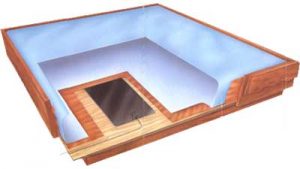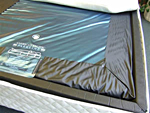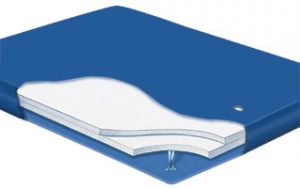
The title of this post sounds like either an ad or a put-down of waterbeds. When waterbeds hit the market in the early 1970s, some people remarked, “You call that a bed?” But waterbeds became wildly popular. In 1987, they constituted about 22% of mattress sales in the United States.
So what are waterbeds? Why did they become popular? Why did they decline? And where are waterbeds today?
Waterbeds are also called water mattresses and flotation beds. The modern waterbed is like a water balloon, but sturdier. It is a bag filled with water and framed to hold its shape. The most common retaining material is polyvinyl chloride (PVC). This bag, or bladder, is filled with fluid, usually water. As the water bears the weight of the sleeper, it fits itself to the body’s shape, like water forms around the hull of a ship. In a sense, the user is floating on the water.
The principal reason waterbeds became popular was pressure relief. This is the reason waterbeds were invented in the first place. When the first modern waterbed went on the market, waterbeds had been in use for close to 150 years.
The first waterbed was the Hydrostatic Bed devised by Dr. Neil Arnott, a Scottish physician. He suspended a canvas sheet over a tub of water. The patient, for whom ordinary filled mattresses were too hard, was placed on the sheet, and the water supported his weight conformably. This relieved pressure on hips, shoulders and any other protruding parts to prevent or relieve bed sores.
Sometime before 1855, waterbeds were being used in hospitals in the United States. They were mentioned in North and South by Elizabeth Gaskel (1855) and A New Beecher Church by Mark Twain (1871).
Science fiction writer Robert Heinlein foresaged several features in modern waterbeds. Why did he do this? His own need for better sleeping support and the time he spent in hospital beds.
It was C. P. Hall in California who finally patented the modern waterbed in 1971. The pressure relief it offered had great appeal. and waterbed manufacturers proliferated. Many innovations made waterbeds even more appealing.
Why did waterbeds decline after gaining over a fifth of the market? The introduction of memory foam mattresses. Memory foam, developed by Tempur Sweden (now Tempur-Pedic) from pressure-relieving viscose foam designed for astronauts, offered pressure relief without the weight of the water and the filling and maintaining of a water mattress. Airbeds also grew in popularity with the Comfortaire mattress.
The waterbed may have declined, but it did not go away. There are several waterbed manufacturers and several outlets for sales. Here is where the Internet may have helped the waterbed industry. With fewer brick-and-mortar retail stores carrying waterbeds, they can be found online.
There are two basic kinds of waterbeds: hardside and softside. In a hardside waterbed, the water mattress is placed in a rigid frame, usually wood, on a solid platform. The frame of a softside waterbed is inside the mattress cover. It is usually made of extremely firm foam. Two advantages of softside water mattresses are they are standard sizes, making buying sheets easier, and they look like a regular mattress.
More graded types of waterbeds are the design of the water chamber. This ranges from the entirely open free-flow water mattress to multiple chambers. In between are various kinds of filling fibers or foams. Some have special structures for lumbar support.
One manufacturer of waterbeds already reviewed on Beds.Org is Boyd Specialty Sleep, marketed under the brand Boyd Flotation. They list 7 softside waterbeds on their Boyd Flotation page (Meridian, Equinox, Cashmere, Pembroke, Dreamscape, Essex, and Brighton), but each of these actually has several models or variations. Boyd also makes hardside waterbeds. These are listed on waterbed retailer websites.
Other top manufacturers of waterbeds include Innomax, American National Manufacturing, Strobel Organic Mattresses, and Sterling Sleep Systems. There also are other lesser-known makers.




Current models of waterbeds are quite sophisticated. And it does not have to stay in one spot for years. Glideaway now has a rolling bed frame made especially to handle the weight of a waterbed. If you need the pressure relief and can handle the weight, you may consider a waterbed along with pocket coils, airbeds, latex mattresses, and memory foam mattresses. Maybe you could float like a boat.
Innomax:
http://www.innomax.com/index2.php?crn=52&action=show&show_products_mode=cat_click
Boyd Specialty Sleep:
http://www.boydspecialtysleep.com/flotation.html
http://www.boydwaterbeds.com/
United States Watermattress:
http://www.watermattress.com/
Sterling Sleep Systems:
https://www.sterlingsleep.com/
Strobel Organic Mattresses:
http://www.strobel.com/waterbeds-main.htm
American National Manufacturing:
http://www.americannationalmfg.com/hardside-waterbeds.html
http://www.americannationalmfg.com/softside-waterbeds.html
Vinyl Products Manufcturing:
www.bedsbyvinylproducts.com
This entry was posted on Wednesday, April 13th, 2016 at 7:52 AM and is filed under beds, buying a mattress, water mattress . You can follow any responses to this entry through the RSS 2.0 feed. You can leave a response, or trackback from your own site.

Get New Post Notification via Email:

For allergy sufferers, a vinyl waterbed bag if properly cared for, is a more sanitary sleeping surface reducing considerably the population of dust mites found on and in regular mattresses; remember the vinyl mattress is a non-porous membrane unlike conventional sprung mattresses which harbor dead skin cells and dust mites that aggravate conditions like asthma and other respiratory disorders; with a regular cleaning program, about once a month wipe down the vinyl surface of a waterbed bag with your vinyl cleaner when the bedding is changed this helps prevent build up of foreign bodies and also looks after the vinyl mattress.